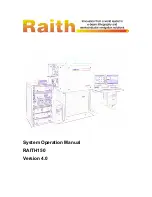
Geode H14000 User Manual
13
Note: A fluorophore might be excited by several LEDs and emit light in different acquisition
channels. This phenomenon can readily be corrected by applying compensation post-image
acquisition (refer to the specific Crystal Miner software User Manual for details available here:
https://www.stillatechnologies.com/technical-resources/naica-system-prism3/
ii.
Non-specific fluorescent intercalating dye: EvaGreen®
Intercalating dyes can also be used with Crystal Digital PCR
TM
like EvaGreen®. EvaGreen® is a
non-mutagenic and non-cytotoxic DNA-
binding dye compatible with Crystal Digital PCR™. Non-
fluorescent when free in solution, it becomes strongly fluorescent upon binding to double-
stranded DNA (dsDNA) in a sequence-independent manner. The signal generated can readily
be detected using the same filters as those used for FAM or fluorescein.
Coupled with Crystal Digital PCR™, EvaGreen® thus enables absolute quantification of a target
by using a simple primer pair.
i) The reference dye
In Crystal
Digital PCR™, reference dyes are used to increase the basal fluorescence of droplets
to enable their detection by the Prism3 and the Crystal Reader software.
Fluorescein is the reference dye for TaqMan® based assays. The naica® multiplex PCR MIX
already contains the reference dye and does not require the addition of fluorescein. Fluorescein
should always be added to the reaction mix when using PCR mixes other than the ready-to-use
naica® multiplex PCR MIX for successful Crystal Digital PCR™ when using TaqMan® probes.
For EvaGreen® based assays the basal fluorescence from the dye is usually sufficient to allow
droplet detection in the blue channel. However, in case the red channel has to be used for droplet
detection, Alexa Fluor® 647 can be added as a reference dye. Stilla Technologies recommends
adding Alexa Fluor® 647 as reference dye to all EvaGreen® experiments.
Please confirm that the droplets have been correctly detected when using a new batch of the
reference dye.
Setting up a
Crystal Digital PCR™ experiment
Preventing DNA contamination
Due to the extraordinary sensitivity of most Taq polymerases, exogenous DNA amplification can
occur and ruin an entire experiment (Kwok and Higuchi, 1989). Since many sources of
contamination exist such as cross-contamination and previous PCR amplification, adhesion to a
strict set of protocols combined with some precautions is essential.
To limit DNA contamination, the following conventional recommendations for PCR should be
followed (not exhaustive):
•
separate areas and dedicate equipment/supplies for sample preparation, PCR setup, PCR
amplification, and analysis of PCR products. Wear a clean lab coat and gloves during each step
of the experiment.
•
clean laboratory benches and equipment periodically with water/ethanol, or with
DNase/RNase away depending on the application (avoid aerosols of cleaning reagents to
prevent negative contamination).
Note: Bleach is not recommended; if its use is unavoidable, ensure abundantly rinsing with water
after the bleach treatment.
•
keep tubes capped as much as possible.
•
centrifuge tubes after vortexing to limit aerosols.
•
monitor potential contaminants by including a no template control.















































